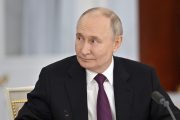
Following Polish President Andrzej Duda’s recent comments that he was prepared for “the Iron Curtain to be rebuilt” to fend off Russia, his government is now following through on these remarks amid rising East-West divisions. The country has stepped up its border security with Belarus, deploying anti-tank fortifications at major crossing points, explicitly indicating that they plan to keep the recently shut border closed.
Polish Defense Minister Mariusz Błaszczak posted images on Twitter of soldiers placing “hedgehogs” — anti-tank obstacles made of metal spikes — and concrete blocks over the crossing. “Today, soldiers started building fortifications on the border with Belarus,” he posted, pointing out that “this is part of our defense and deterrence strategy.”
Last month, Polish servicemen also installed similar anti-tank barriers along the country’s border with Russia‘s Kaliningrad region. Besides, the Polish authorities inked a $84 million deal for the construction of an electronic barrier on the border with Russia.
The fence on the main section of Poland’s border with Belarus measures 186 kilometers (115 miles) long and five meters (16 feet) high, whereas its cost is estimated at 1.6 billion zlotys ($400 million). Furthermore, night-vision cameras, motion sensors, and other electronics presently bedeck the fence.
Relations between Poland and Belarus are currently very frosty. On one hand, Poland is a staunch advocate for Ukraine in its defense against Russia. In fact, Poland was the first country to send its Leopard tanks to conflict-ridden Ukraine. After the first batch of four, another 10 were deployed. The pledge to send fighter jets is another move in Warsaw’s military support of Kyiv.
“The remaining part of the MiG-29s which we have in Poland, which are operational, and which are now serving in our Air Force — we stand ready to provide those planes, and I’m sure that Ukraine would be ready to use those planes instantly because Ukraine has got pilots able to operate those machines, right now,” Duda told CNN’s Becky Anderson during his visit to the United Arab Emirates.
Duda elaborated that he thinks Ukraine’s armed forces would want to be “up to the NATO standard” and so would want to use F-16 jets. Hence, Ukrainian pilots will have to be trained to operate them, he maintained.
Alluding to his earlier conversation with his Ukrainian counterpart Volodymyr Zelensky, Duda said that Ukraine’s “key requirement” at the moment was long-range artillery, as reported by the Polish Press Agency.
The number of fighters Poland would donate to war-torn Ukraine “would not be large” and certainly not as big as the number of tanks, Paweł Szrot, chief of the president’s cabinet, told Radio Plus.
Poland would be keen to donate the jets “as part of some larger international coalition so that Ukraine can really feel that support,” said Szrot.
To add salt to already wounded ties, Warsaw has long backed the Belarusian opposition and has been especially infuriated at Belarus’ recent imprisonment of an ethnic Polish journalist for eight years.
In turn, Belarus, a close ally of Moscow, slammed the Polish Special Forces for their involvement in an attempted terror attack. On February 20 this year, Alexander Lukashenko, the president of Belarus, revealed a plan to set up a paramilitary defense force to protect Belarus against invasion. Lukashenko’s declaration came amid continuing rumors over Belarus’ possible involvement in Ukraine.
Lukashenko put forth his belief in having an armed population, saying, “The situation is not easy. I have said more than once: every man … should be able to at least handle weapons, at least in order to protect his family, if needed, his home, his own piece of land and, if necessary, his country.”
Also, Belarusian Defence Minister Viktor Khrenin stated that the force should be between 100,000 and 150,000 men. Comprising mainly volunteers, those involved in the territorial defense force would serve and train part-time, while working their day jobs. The force would support Belarus’ 48,000-strong army and 12,000-strong border guard, and would act as a guerilla corps should the country be invaded.
The policy brought to mind comments made by Lukashenko last autumn when he suggested deploying the population to gather the fall grain harvest. Although Belarus continues to deepen its bilateral ties with Russia, it abides by an autarchic policy in economy and defense.
Belarus was used as a platform by Russian forces last year during an offensive on Kyiv in the opening weeks of the Ukraine conflict, although it has not directly participated in the conflict.
Belarus has been recently cautioning against potential border trespassing from Ukraine. Minsk has asserted that a considerable number of Ukrainian troops have been concentrated near their shared border.
Although almost all the regional countries bordering Ukraine have backed Zelensky’s regime, Belarus not only maintains warm relations with Moscow, but looks to deepen its ties with Russia even more.
Since February, Poland has been shutting its border crossings with Belarus. Although Poland had already established fences in response to the migrant border crisis of 2021-2022, travel and trade still took place between the two countries. Nonetheless, on February 21, both countries announced that their borders were closed.
One reporter from The Times Hub compared the situation to a “new Berlin Wall,” and portrayed border communities that have become virtual ghost towns over the past month.
Overall, the installation of anti-tank fortifications is just the most recent update in what is quickly becoming a new hotbed in the ongoing conflict between Eastern and Western Europe. With other countries such as Finland building a fence along its border with Russia, it is no wonder why observers are alluding to the “new Iron Curtain” when talking about the situation in Europe, a situation that could have longstanding ramifications should it be blown out of proportion.




